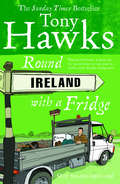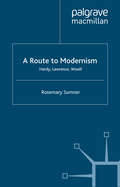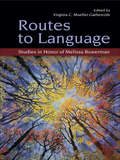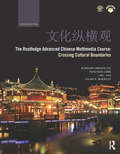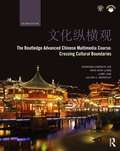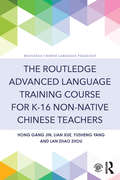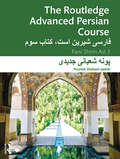- Table View
- List View
Round Ireland With A Fridge: On-line Retail
by Tony Hawks'I hereby bet Tony Hawks the sum of One Hundred Pounds that he cannot hitchhike round the circumference of Ireland, with a fridge, within one calendar month'A foolhardy attempt to win a drunken bet led to Tony Hawks having one of the most unforgettable experiences of his life. Joined by his trusty travelling-companion-cum-domestic-appliance, he found himself in the midst of a remarkable, inspirational and, at times, downright silly adventure.In their month of madness, Tony and his fridge surfed together; entered a batchelor festival; and one of them had sex without the other knowing. The fridge got christened, and they even met the poorest king on Earth.An absurd story of an extraordinary adventure, Round Ireland with a Fridge follows the fearless pair as they battle towards Dublin and a breathtaking finale that is moving, uplifting, and a fitting conclusion to the whole ridiculous affair.
Rousseau and Romanticism
by Otto ScottThis volume is the best-known and most widely discussed work of the influential scholar and critic Irving Babbitt (1865-1933), intellectual leader of the movement known as the New Humanism. It is also the work that best conveys the ethical and aesthetic core of his thought. Broad in scope, it examines a variety of manifestations of romanticism and presents a typology of the imaginative inclinations of that movement Rousseau is analyzed as paradigmatic of the ethical and aesthetic sensibility that is replacing the classical and Christian outlook in the Western world. For Babbitt, works of imagination are integral to human life in general. He explores romanticism with a view to its implications for Western civilization.Babbitt identifies serious ethical, religious, aesthetic, and philosophical problems in the modern world, but he also shows how remedies to those problems must incorporate the best insights of modernity. First published in 1919, the book is strikingly relevant to today's discussion of the crisis of American and Western culture and education. Babbitt anticipated and analyzed dangerous cultural trends whose consequences are now widely bemoaned. He applies to these phenomena an intellectual breadth and depth rare today. At the end of the twentieth century his prescriptions for dealing with the central problems of Western civilization have acquired an acute urgency. At a time of much renewed interest in Rousseau, Babbitt's book offers a penetrating commentary that challenges widely held beliefs and interpretations.Graced with a lengthy and wide-ranging new introduction by Claes G. Ryn, Rousseau and Romanticism is simultaneously a work of literary history, criticism, and a theory of civilization. In addressing its special subject, this classic study reflects the main themes of Babbitt's thought, making it representative of his work as a whole. Ryn explicates and critically assesses Babbitt's central ideas, refutes widely circulating
Rousseau and Romanticism (Library Of Conservative Thought Ser. #No. Ii)
by Otto ScottThis volume is the best-known and most widely discussed work of the influential scholar and critic Irving Babbitt (1865-1933), intellectual leader of the movement known as the New Humanism. It is also the work that best conveys the ethical and aesthetic core of his thought. Broad in scope, it examines a variety of manifestations of romanticism and presents a typology of the imaginative inclinations of that movement Rousseau is analyzed as paradigmatic of the ethical and aesthetic sensibility that is replacing the classical and Christian outlook in the Western world. For Babbitt, works of imagination are integral to human life in general. He explores romanticism with a view to its implications for Western civilization.Babbitt identifies serious ethical, religious, aesthetic, and philosophical problems in the modern world, but he also shows how remedies to those problems must incorporate the best insights of modernity. First published in 1919, the book is strikingly relevant to today's discussion of the crisis of American and Western culture and education. Babbitt anticipated and analyzed dangerous cultural trends whose consequences are now widely bemoaned. He applies to these phenomena an intellectual breadth and depth rare today. At the end of the twentieth century his prescriptions for dealing with the central problems of Western civilization have acquired an acute urgency. At a time of much renewed interest in Rousseau, Babbitt's book offers a penetrating commentary that challenges widely held beliefs and interpretations.Graced with a lengthy and wide-ranging new introduction by Claes G. Ryn, Rousseau and Romanticism is simultaneously a work of literary history, criticism, and a theory of civilization. In addressing its special subject, this classic study reflects the main themes of Babbitt's thought, making it representative of his work as a whole. Ryn explicates and critically assesses Babbitt's central ideas, refutes widely circulating
Rousseau: The Discourses And Other Early Political Writings (Cambridge Texts In The History Of Political Thought Ser.)
by Jean-Jacques Rousseau Victor GourevitchA comprehensive and authoritative anthology of Rousseau's important early political writings in faithful English translations. This volume includes the Discourse on the Sciences and Arts and the Discourse on the Origin and the Foundations of Inequality among Men - the so-called First and Second Discourses - together with Rousseau's extensive Replies to critics of these Discourses; the Essay on the Origin of Languages; the Letter to Voltaire on Providence; as well as several minor but illuminating writings - the Discourse on Heroic Virtue and the essay Idea of the Method in the Composition of a Book. In these as well as in his later writings, Rousseau probes the very premises of modern thought. His influence was wide-reaching from the very first, and it has continued to grow since his death. The American and the French Revolutions were profoundly affected by his thought, as were Romanticism and Idealism. This new edition features up-to-date translations, an expanded introduction, and an extensive editorial apparatus designed to assist students at every level access these seminal texts.
Rousseau et les philosophes (Oxford University Studies in the Enlightenment #2010:12)
On ne peut penser les Lumières sans l’auteur du Contrat social et l’Emile, mais on ne saurait cependant nier que Rousseau dénonce les ‘philosophes modernes’ dans les termes les plus forts. Comment donc penser les rapports entre Rousseau et les philosophes?Dans ce volume les spécialistes de Rousseau vont au-delà des oppositions figées. Ils montrent comment le ‘citoyen de Genève’, à partir de sources philosophiques partagées avec ses contemporains, délimite le champ de la raison et construit une pensée politique rigoureuse, s’imposant ainsi à ceux qui souvent rejettent ses idées religieuses ou sa dénonciation des sciences et des arts. Confrontant la richesse irréductible de ses écrits, les auteurs proposent le portrait intellectuel d’un homme qui construit sa pensée à la fois avec et contre les philosophes, les obligeant à justifier ou à modifier leurs propres convictions face au défi que représente son œuvre.Figure emblématique de son siècle, Rousseau suscite l’indignation mais oblige aussi à des réexamens difficiles. C’est par l’étude de cette position à la fois centrale et marginale que l’on peut saisir la force de sa pensée et discerner ce qu’elle signifie pour nous.
Rousseau in Drag: Deconstructing Gender (Breaking Feminist Waves)
by R. KennedyThrough a series of close readings of most of Rousseau's major writings, this book provides a new interpretation of the eighteenth-century philosopher's sexual politics. The text argues that Rousseau's writings provide a critique of not only normative gender identity, but also normative familial and kinship relations.
Rousseau-Kant-Goethe
by Ernst CassirerTranslated by James Gutmann, Paul Oskar Kristeller, and John Herman Randall, Jr.Originally published in 1945.The Princeton Legacy Library uses the latest print-on-demand technology to again make available previously out-of-print books from the distinguished backlist of Princeton University Press. These editions preserve the original texts of these important books while presenting them in durable paperback and hardcover editions. The goal of the Princeton Legacy Library is to vastly increase access to the rich scholarly heritage found in the thousands of books published by Princeton University Press since its founding in 1905.
Rousseauism and Education in Eighteenth-century France (Oxford University Studies in the Enlightenment #325)
by Jean BlochThis volume examines the evolving reputation of Rousseau as an authority on education in France from the publication of Emile in 1762 to the fall of the Jacobins in 1794. It takes as its focus the centrality of the debate over private and public education.The author argues that what unites Rousseau and the Revolutionaries is their holistic approach, which perceives an organic relationship between the internal constitution of the person as a moral and emotional being and what are normally thought of as external public matters such as politics. Education is, in fact, the key to Rousseau’s philosophy and it is also the key to revolutionary change. The Revolutionaries may start by looking at the necessary reform of the monarchy or the taxation system, but as things develop, they realise that if the Revolution is to last, education must be appropriate to it. In this way the Revolutionaries are obliged to consider education as a tool for thinking about the very problem Rousseau had perceived: the connection between the inner self and society and its institutions.The study examines the way in which the early revolutionaries are faced by Rousseau’s already established reputation as an authority on private education and how this poses problems for them. Linked too emphatically with individualism and the private sphere, Rousseau represents an ambiguous symbol for those concerned with the reform of public education. Yet, his reputation in the field of child care the developing cult of him as inspiration and symbol of the Revolution make him an almost obligatory reference point for educational reformers. The author’s analysis traces the progression of the Revolutionaries’ attitudes.The volume demonstrates how the first thirty to thirty-five years of the fortunes of Rousseau’s reputation as an educationist have, arguably, more to do with politics than pedagogy. Two major phases of the intermeshing of education and politics around the figure of Rousseau can be seen: the first in the years following the publication of Emile, when the supporters of absolute monarchy show their suspicion of the radical implications of Emile, and the second in mid-Revolution, when the association of Rousseau and his political doctrine spills over into the plans of educational reform. This volume charts the progress of these developments and casts new light on the vexed question of the relationship of Rousseau to the French Revolution.
Rousseau's Legacy: Emergence and Eclipse of the Writer in France
by Dennis PorterRousseau's Legacy focuses on the new and influential paradigm of the writer that emerged in the decades immediately preceding the French Revolution. Ushered in by Rousseau's combining revolutionary sociopolitical critique with a new art of autobiography, the writer would henceforth differ greatly from the traditional "man of letters." Rousseau inaugurated the idea of a heroic and committed writerly life in which the opposition between public and private selves is collapsed. This was done in the cause of creating a future political community founded on transparency. Porter, with both a wide-ranging knowledge of contemporary theory and an informed interest in cultural/historical context, gives close readings of relevant works by a number of major French writers, including Stendhal, Baudelaire, Sartre, Barthes, Duras, Althusser, and Foucault. Thus, he explores the persistent importance of the Rousseauist paradigm for French literary culture. The book goes beyond a critique or theory that interprets literary or philosophical works for their own sake, to reveal representations and self-representations of the idea of the writer in paintings, engravings, and photographs, as well as in literary texts. In concluding, Porter argues that with the collapse of faith in social and individual regeneration through revolution, the archetype of such a writer is also waning.
Rousseau's Reader: Strategies of Persuasion and Education
by John T. ScottOn his famous walk to Vincennes to visit the imprisoned Diderot, Rousseau had what he called an “illumination”—the realization that man was naturally good but becomes corrupted by the influence of society—a fundamental change in Rousseau’s perspective that would animate all of his subsequent works. At that moment, Rousseau “saw” something he had hitherto not seen, and he made it his mission to help his readers share that vision through an array of rhetorical and literary techniques. In Rousseau’s Reader, John T. Scott looks at the different strategies Rousseau used to engage and persuade the readers of his major philosophical works, including the Social Contract, Discourse on Inequality, and Emile. Considering choice of genre; textual structure; frontispieces and illustrations; shifting authorial and narrative voice; addresses to readers that alternately invite and challenge; apostrophe, metaphor, and other literary devices; and, of course, paradox, Scott explores how the form of Rousseau’s writing relates to the content of his thought and vice versa. Through this skillful interplay of form and content, Rousseau engages in a profoundly transformative dialogue with his readers. While most political philosophers have focused, understandably, on Rousseau’s ideas, Scott shows convincingly that the way he conveyed them is also of vital importance, especially given Rousseau’s enduring interest in education. Giving readers the key to Rousseau’s style, Scott offers fresh and original insights into the relationship between the substance of his thought and his literary and rhetorical techniques, which enhance our understanding of Rousseau’s project and the audiences he intended to reach.
Rousseau's Reader: Strategies of Persuasion and Education
by John T. ScottOn his famous walk to Vincennes to visit the imprisoned Diderot, Rousseau had what he called an “illumination”—the realization that man was naturally good but becomes corrupted by the influence of society—a fundamental change in Rousseau’s perspective that would animate all of his subsequent works. At that moment, Rousseau “saw” something he had hitherto not seen, and he made it his mission to help his readers share that vision through an array of rhetorical and literary techniques. In Rousseau’s Reader, John T. Scott looks at the different strategies Rousseau used to engage and persuade the readers of his major philosophical works, including the Social Contract, Discourse on Inequality, and Emile. Considering choice of genre; textual structure; frontispieces and illustrations; shifting authorial and narrative voice; addresses to readers that alternately invite and challenge; apostrophe, metaphor, and other literary devices; and, of course, paradox, Scott explores how the form of Rousseau’s writing relates to the content of his thought and vice versa. Through this skillful interplay of form and content, Rousseau engages in a profoundly transformative dialogue with his readers. While most political philosophers have focused, understandably, on Rousseau’s ideas, Scott shows convincingly that the way he conveyed them is also of vital importance, especially given Rousseau’s enduring interest in education. Giving readers the key to Rousseau’s style, Scott offers fresh and original insights into the relationship between the substance of his thought and his literary and rhetorical techniques, which enhance our understanding of Rousseau’s project and the audiences he intended to reach.
Rousseau's Reader: Strategies of Persuasion and Education
by John T. ScottOn his famous walk to Vincennes to visit the imprisoned Diderot, Rousseau had what he called an “illumination”—the realization that man was naturally good but becomes corrupted by the influence of society—a fundamental change in Rousseau’s perspective that would animate all of his subsequent works. At that moment, Rousseau “saw” something he had hitherto not seen, and he made it his mission to help his readers share that vision through an array of rhetorical and literary techniques. In Rousseau’s Reader, John T. Scott looks at the different strategies Rousseau used to engage and persuade the readers of his major philosophical works, including the Social Contract, Discourse on Inequality, and Emile. Considering choice of genre; textual structure; frontispieces and illustrations; shifting authorial and narrative voice; addresses to readers that alternately invite and challenge; apostrophe, metaphor, and other literary devices; and, of course, paradox, Scott explores how the form of Rousseau’s writing relates to the content of his thought and vice versa. Through this skillful interplay of form and content, Rousseau engages in a profoundly transformative dialogue with his readers. While most political philosophers have focused, understandably, on Rousseau’s ideas, Scott shows convincingly that the way he conveyed them is also of vital importance, especially given Rousseau’s enduring interest in education. Giving readers the key to Rousseau’s style, Scott offers fresh and original insights into the relationship between the substance of his thought and his literary and rhetorical techniques, which enhance our understanding of Rousseau’s project and the audiences he intended to reach.
Rousseau's Reader: Strategies of Persuasion and Education
by John T. ScottOn his famous walk to Vincennes to visit the imprisoned Diderot, Rousseau had what he called an “illumination”—the realization that man was naturally good but becomes corrupted by the influence of society—a fundamental change in Rousseau’s perspective that would animate all of his subsequent works. At that moment, Rousseau “saw” something he had hitherto not seen, and he made it his mission to help his readers share that vision through an array of rhetorical and literary techniques. In Rousseau’s Reader, John T. Scott looks at the different strategies Rousseau used to engage and persuade the readers of his major philosophical works, including the Social Contract, Discourse on Inequality, and Emile. Considering choice of genre; textual structure; frontispieces and illustrations; shifting authorial and narrative voice; addresses to readers that alternately invite and challenge; apostrophe, metaphor, and other literary devices; and, of course, paradox, Scott explores how the form of Rousseau’s writing relates to the content of his thought and vice versa. Through this skillful interplay of form and content, Rousseau engages in a profoundly transformative dialogue with his readers. While most political philosophers have focused, understandably, on Rousseau’s ideas, Scott shows convincingly that the way he conveyed them is also of vital importance, especially given Rousseau’s enduring interest in education. Giving readers the key to Rousseau’s style, Scott offers fresh and original insights into the relationship between the substance of his thought and his literary and rhetorical techniques, which enhance our understanding of Rousseau’s project and the audiences he intended to reach.
Rousseau's Venetian Story: An Essay upon Art and Truth in Les Confessions
by Madeleine B. EllisThis book is primarily a literary study of Rousseau's account of his diplomatic experiences in Venice, contained in book 7 of the Confessions and written in 1769. The author analyzes Rousseau's methods of achieving an artistic rendering of psychological truth in autobiography, as exemplified in his treatment of the events of 1742–1749. Professor Madeleine Ellis contributes to an understanding of Rousseau as a creative artist and positions him vis-à-vis the classical and romantic movements. Ellis collates the text of the Confessions with contemporary correspondence and other documents to show how discrepancies between the two have artistic implications. These implications lead her to define Rousseau's principles and methods as a man of letters and the interrelations of art and truth in his memoirs. In revealing that Rousseau, the memorialist, gives an artistic rendering of psychological truth, Ellis shows Rousseau's attitude toward truth. She does this by following a path of analysis unexplored by previous critics but indicated by Rousseau himself when he says, "It is the story of my soul that I have promised... I record not so much the events of my life as the state of my soul as they happened." Ultimately, the objective of this study is to illustrate the artistic means—literary and rhetorical—employed by Rousseau and their implications for the truth he proposed.
Rousseau's Venetian Story: An Essay upon Art and Truth in Les Confessions
by Madeleine B. EllisOriginally published in 1966. This book is primarily a literary study of Rousseau's account of his diplomatic experiences in Venice, contained in book 7 of the Confessions and written in 1769. The author analyzes Rousseau's methods of achieving an artistic rendering of psychological truth in autobiography, as exemplified in his treatment of the events of 1742–1749. Professor Madeleine Ellis contributes to an understanding of Rousseau as a creative artist and positions him vis-à-vis the classical and romantic movements. Ellis collates the text of the Confessions with contemporary correspondence and other documents to show how discrepancies between the two have artistic implications. These implications lead her to define Rousseau's principles and methods as a man of letters and the interrelations of art and truth in his memoirs. In revealing that Rousseau, the memorialist, gives an artistic rendering of psychological truth, Ellis shows Rousseau's attitude toward truth. She does this by following a path of analysis unexplored by previous critics but indicated by Rousseau himself when he says, "It is the story of my soul that I have promised... I record not so much the events of my life as the state of my soul as they happened." Ultimately, the objective of this study is to illustrate the artistic means—literary and rhetorical—employed by Rousseau and their implications for the truth he proposed.
Rousseau's Venetian Story: An Essay upon Art and Truth in Les Confessions
by Madeleine B. EllisOriginally published in 1966. This book is primarily a literary study of Rousseau's account of his diplomatic experiences in Venice, contained in book 7 of the Confessions and written in 1769. The author analyzes Rousseau's methods of achieving an artistic rendering of psychological truth in autobiography, as exemplified in his treatment of the events of 1742–1749. Professor Madeleine Ellis contributes to an understanding of Rousseau as a creative artist and positions him vis-à-vis the classical and romantic movements. Ellis collates the text of the Confessions with contemporary correspondence and other documents to show how discrepancies between the two have artistic implications. These implications lead her to define Rousseau's principles and methods as a man of letters and the interrelations of art and truth in his memoirs. In revealing that Rousseau, the memorialist, gives an artistic rendering of psychological truth, Ellis shows Rousseau's attitude toward truth. She does this by following a path of analysis unexplored by previous critics but indicated by Rousseau himself when he says, "It is the story of my soul that I have promised... I record not so much the events of my life as the state of my soul as they happened." Ultimately, the objective of this study is to illustrate the artistic means—literary and rhetorical—employed by Rousseau and their implications for the truth he proposed.
A Route to Modernism: Hardy, Lawrence, Woolf
by R. SumnerThe question 'What is modernism?' has provoked intense critical discussion. A Route to Modernism explores this area; it focuses on the strange and dangerous journey taken by Hardy, Lawrence and Woolf towards unknown regions of the mind and the universe. In a discussion of these novelists, both individually and in relation to one another, a radical reconsideration of modernism is developed. Woolf envisaged her contemporaries 'flashing past on another railway line'. A Route to Modernism shows the hypothetical train of Hardy, Lawrence and Woolf not following an existing track but tunnelling beneath surfaces, following routes which are 'spasmodic, fragmentary', sometimes taking off like a rocket into the cosmos. Their fragmented, modernist works deny us 'the comfort of ... a single meaning, either in works of art or in the world'. This book offers new approaches to modernism, while insisting on books being left 'open - no conclusion come to '.
Routes to Language: Studies in Honor of Melissa Bowerman
by Virginia C. Mueller GathercoleThis volume contains contributions from leaders in the field of child language in honor of one of the preeminent scholars in the field of child language acquisition, Melissa Bowerman. Melissa Bowerman has had a profound, widespread, and enduring influence on research conducted in the field for nearly 40 years. In addition to being a tribute to Professor Bowerman and her work, the chapters provide the most up-to-date statement of key positions by several leaders in the field of child language development. Fundamental questions in the field are explored in depth, and there are rich analyses of progress in the field in a number of areas, including learning words; crosslinguistic patterning and acquisition of lexical semantics; crosslinguistic patterning and events, paths, and causes; and influences on development. The volume is essential reading for researchers in child language and development, linguistics, psychology, education, and speech pathology, as well as researchers and practitioners specializing in the many specific languages discussed in the book.
Routes to Language: Studies in Honor of Melissa Bowerman
by Virginia C. Mueller GathercoleThis volume contains contributions from leaders in the field of child language in honor of one of the preeminent scholars in the field of child language acquisition, Melissa Bowerman. Melissa Bowerman has had a profound, widespread, and enduring influence on research conducted in the field for nearly 40 years. In addition to being a tribute to Professor Bowerman and her work, the chapters provide the most up-to-date statement of key positions by several leaders in the field of child language development. Fundamental questions in the field are explored in depth, and there are rich analyses of progress in the field in a number of areas, including learning words; crosslinguistic patterning and acquisition of lexical semantics; crosslinguistic patterning and events, paths, and causes; and influences on development. The volume is essential reading for researchers in child language and development, linguistics, psychology, education, and speech pathology, as well as researchers and practitioners specializing in the many specific languages discussed in the book.
The Routledge Advanced Chinese Multimedia Course: Crossing Cultural Boundaries
by Carolyn Lee Hsin-Hsin Liang Liwei Jiao Julian WheatleyThe Routledge Advanced Chinese Multimedia Course: Crossing Cultural Boundaries is an innovative multimedia course for advanced students of Chinese. Written by a team of highly experienced instructors, the book offers advanced learners the opportunity to consolidate their knowledge of Chinese through a wide range of activities designed to build up both excellent language skills and cultural literacy.? Divided into four thematic units covering popular culture, social change, cultural traditions, and politics and history, with each unit presenting three individual lessons, the volume provides students with a structured course which efficiently supports the transition from an intermediate to an advanced level. The many different texts featured throughout the lessons present interesting and accurate information about contemporary China and introduce students to useful vocabulary, speech patterns, and idiosyncratic language usage. Key features include Lively and detailed discussions of grammatical points and sentence patterns Engaging exercises for developing grammatical concepts and insight into the character writing system Systematic review of earlier material to ensure consolidation of learning Coverage of diverse and culturally relevant topics such as online dating, changing views of marriage, food culture, Confucianism? and democracy in China. Extensive cultural and historical notes providing background to the subjects presented Complementary CDs to enhance listening skills. Free companion website (http://duke.edu/web/chinesesoc/) offering a wealth of video content forming the basis of many of the listening activities linked to topics within the book. Extensively revised and updated throughout, this new edition includes new material and activities on synonyms and substantial improvements to the "composition", "Focus on characters" and "Language practicum" sections. The improved Instructor’s Resource Manual, which includes activity tips, additional exercises, answer keys and the traditional character texts, is available at http://www.routledge.com/books/details/9780415841337/
The Routledge Advanced Chinese Multimedia Course: Crossing Cultural Boundaries
by Carolyn Lee Hsin-Hsin Liang Liwei Jiao Julian WheatleyThe Routledge Advanced Chinese Multimedia Course: Crossing Cultural Boundaries is an innovative multimedia course for advanced students of Chinese. Written by a team of highly experienced instructors, the book offers advanced learners the opportunity to consolidate their knowledge of Chinese through a wide range of activities designed to build up both excellent language skills and cultural literacy.? Divided into four thematic units covering popular culture, social change, cultural traditions, and politics and history, with each unit presenting three individual lessons, the volume provides students with a structured course which efficiently supports the transition from an intermediate to an advanced level. The many different texts featured throughout the lessons present interesting and accurate information about contemporary China and introduce students to useful vocabulary, speech patterns, and idiosyncratic language usage. Key features include Lively and detailed discussions of grammatical points and sentence patterns Engaging exercises for developing grammatical concepts and insight into the character writing system Systematic review of earlier material to ensure consolidation of learning Coverage of diverse and culturally relevant topics such as online dating, changing views of marriage, food culture, Confucianism? and democracy in China. Extensive cultural and historical notes providing background to the subjects presented Complementary CDs to enhance listening skills. Free companion website (http://duke.edu/web/chinesesoc/) offering a wealth of video content forming the basis of many of the listening activities linked to topics within the book. Extensively revised and updated throughout, this new edition includes new material and activities on synonyms and substantial improvements to the "composition", "Focus on characters" and "Language practicum" sections. The improved Instructor’s Resource Manual, which includes activity tips, additional exercises, answer keys and the traditional character texts, is available at http://www.routledge.com/books/details/9780415841337/
The Routledge Advanced Language Training Course for K-16 Non-native Chinese Teachers (Routledge Chinese Language Pedagogy)
by Hong Gang Jin Lian Xue Yusheng Yang Lan Zhao ZhouThe Routledge Advanced Language Training Course for K-16 Non-native Chinese Teachers is a content-based and thematically organized textbook designed for non-native in- and pre-service K-16 Chinese language teachers. Based on five years of field testing, the book offers an innovative approach to advanced language instruction, allowing users to further advance their language proficiency while continuing their professional development in teaching Chinese as a second or foreign language. The textbook: covers a range of up-to-date pedagogical and cultural themes provides a variety of engaging activities and exercises, allowing readers for K-16 to explore pedagogical and cultural issues in the target language with best classroom practices in mind familiarises users with authentic forms of modern communication in today’s China to better engage learners is accompanied by a Companion Website with audio recordings for each lesson as well as supplementary materials and teaching resources. The Routledge Advanced Language Training Course for K-16 Non-native Chinese Teachers is an essential resource for non-native Chinese teachers and for those on TCFL teacher training programs.
The Routledge Advanced Language Training Course for K-16 Non-native Chinese Teachers (Routledge Chinese Language Pedagogy)
by Hong Gang Jin Lian Xue Yusheng Yang Lan Zhao ZhouThe Routledge Advanced Language Training Course for K-16 Non-native Chinese Teachers is a content-based and thematically organized textbook designed for non-native in- and pre-service K-16 Chinese language teachers. Based on five years of field testing, the book offers an innovative approach to advanced language instruction, allowing users to further advance their language proficiency while continuing their professional development in teaching Chinese as a second or foreign language. The textbook: covers a range of up-to-date pedagogical and cultural themes provides a variety of engaging activities and exercises, allowing readers for K-16 to explore pedagogical and cultural issues in the target language with best classroom practices in mind familiarises users with authentic forms of modern communication in today’s China to better engage learners is accompanied by a Companion Website with audio recordings for each lesson as well as supplementary materials and teaching resources. The Routledge Advanced Language Training Course for K-16 Non-native Chinese Teachers is an essential resource for non-native Chinese teachers and for those on TCFL teacher training programs.
The Routledge Advanced Persian Course: Farsi Shirin Ast 3
by Pouneh Shabani-JadidiThe Routledge Advanced Persian Course: Farsi Shirin Ast 3 aims to help students of higher-level proficiency continue elevating their proficiency level to achieve near-native level. Key features include: Authentic texts on a variety of topics related to Iran’s history, geography, arts, literature, culture, religions, society, and people. Each lesson includes a prominent poet and their most representative poem familiarizing students with the Persian literary canon, while indirectly learning the higher order registers used in the language of poetry. Lessons end with a Persian proverb and the story behind it, so that students will not only master the language but also the culture of the language and reach a near-native level of linguistic and cultural proficiency. The proverbs and some of the classical poetry are written in the calligraphy form to make students get used to reading handwritten texts resembling calligraphy. Audio files are provided so that learners who are studying on their own can have access to correct pronunciations. This textbook continues the series from The Routledge Intermediate Course in Persian and is ideal for Advanced or B2-C1 level students of Persian.
